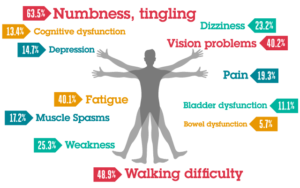
As I prepare for Mexico, I want to document my current MS symptoms as they exist right now as a baseline before treatment. This post is a long one, buckle up (or ignore 🙂 ).
There will be no objective way to determine if the HSCT treatment has halted my MS progression. Since my original MRI in 2007 that clearly demonstrated that I had MS with a classic lesion/flare pattern in my brain, I have not had another, single change in my subsequent MRI scans. Without ongoing flares/lesions, there’s no way to determine if the frequency has changed or stopped altogether.
There is not a blood test that identifies MS or MS activity. No biomarker of any sort. The only way to demonstrate or document my progression, or lack of progression, is my experience of my body. This is how my neurologist has assessed my progression to this point and it is really the only way science knows to assess a person with a progressive form of MS.
So, there will be no objective measure to determine if HSCT has halted my disease progression except my own observation. And that clarity will not be a quick process because healing after HSCT is commonly 1-2 years.
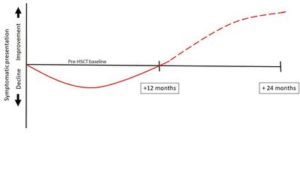
HSCT is designed to halt progression and it is not a guarantee that it will do even that, though the odds are around 70-80% that it will. It is explicitly not an expectation that any existing symptoms will improve, but there are many reports of improvement from small to significant.

Some people report distinct changes right away that help them know it has worked. For some, the symptom of debilitating fatigue lifts and doesn’t come back. Some have reported that spasticity in legs or arms seems to let go and remain improved. A common symptom improvement that people report is a marked difference in bladder symptoms, which I will go into more detail later! For most people, any symptom improvement is a slow, plodding process.
The symptoms documented here are, right leg spasticity and mobility challenges and how that relates to walking, right arm and hand spasticity and contracture and the impact that has on activities of daily living (ADLs) and handwriting/typing, fatigue, bladder issues, bowel issues. You are welcome to read these and skip over any sections that make you squeamish.
Right Leg Spasticity/Mobility
The symptom that first had me go to a neurologist was foot drop. This is where it becomes difficult to pick up your foot, or more specifically your toe, to walk. It is easy to catch my toe and trip because of this. To decrease the likelihood of tripping or falling, it is common to start doing what is known as a “circumduction gait” where you swing your leg from the hip, out and around, to help that foot clear the ground. This can start out subtly and increase over time.
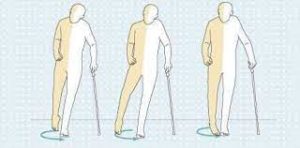
In my case, foot drop has become more pronounced and my foot likes to curl in and down. There is also intense spasticity in my ankle, my knee joint, and my hip joint. Every point along the path of my leg resists moving normally. In addition to the spasticity, the leg has become quite weak over time and some of the muscles have atrophied, especially the glute muscles and hip flexors. They are simultaneously incredibly high tone and tight and very weak.
Video taken Jan., 2022
There is a test I do every time I go into my neurologist’s office called the “25-foot timed test” this is where you simply walked 25 feet as fast as you can and get timed to see if your time changes between visits. It is a crude test and I’m basically capable of walking at an okay clip for 25 feet but further than that that and I get weak and slow. Because the test is only 25 feet, it does actually catch much of the important changes.
I am currently able to walk around inside my house if I rest frequently. I try to minimize going up and down stairs because it’s exhausting, but I can still technically do it. I use the provided scooters at the grocery store to shop. While it is hard to quantify how long or far I can walk, I would say I can walk outside on even ground for about 100 feet before I need to rest. I push myself further than that if I must, but it costs me. If the ground is uneven, I need trekking polls or walking sticks and I can go less distance. I need visual cues to walk safely and I am significantly less stable on both even ground and in the dark or lowlight.
Spasticity has an impact on my circulation. My right foot is constantly cold because there is less blood flow to the extremity. My ankle commonly swells, and my foot is often discolored, either white or purple depending on the day.
About a year and ½ ago I had a left-sided gas pedal installed in my car so I could drive safely, and I had to train my left leg to do what my right leg had done instinctively for the last almost 25 years. At first, I hadn’t known that accommodation was possible, and I had been confronted with losing my autonomy with driving. I hid from myself and others that I was feeling less and less safe driving, scared that I couldn’t stop quickly enough, scared that my foot might get caught underneath a pedal. But I wasn’t ready to let go of the freedom and independence that comes with driving. I know what it feels like to be the elder person whose family is needing to take away their driver’s license.
Right Arm Spasticity
I am right hand dominant. I write with my right hand, I use that hand to type, I cook and prep food mostly with my right hand, I eat my food with a fork or spoon with my right hand, just about everything I do depends on my having a competent right hand. Try putting your dominant hand in a fist and then putting it in a mitten and see how many things you use it for.
The change in my right arm and hand happen slowly over time. I remember looking at a photograph of me jumping out of the water in Hawaii in 2013.

In that photograph my left arm was straight up and exuberant and my right arm was as exuberant but crooked at the elbow. I hadn’t noticed that as I went through my day, but that photo caught my attention.
By 2015 I needed to switch from typing to voice dictation and by 2018 even the simplest bit of handwriting became difficult. My bicep muscle is so incredibly tight it pulls my lower arm in and the muscles in my forearm and hand contract my fingers into a claw type posture. I now need help filling out forms I can’t fill in on the computer. Any writing or journaling I want to do I have to do out loud with voice dictation. I eat with my left hand, which is clumsy. Nils will typically cut my food for me because that takes two hands. I wear very few articles of clothing with buttons, snaps, or zippers. I don’t wear shoes with laces. It has become difficult to do the most personal and identity defining act of signing my name.
Video Taken Jan., 2022
This hand and arm have a similar circulation issue to my leg and foot. It is frequently very cold; the texture of the skin has changed as has the character of my fingernails.
Though it is hard to do physical therapy for my foot and legs and hips, it still feels doable and like it makes a difference. Doing physical therapy for my arm and hand is incredibly confronting. Every movement feels almost impossible and my belief in its ability to make a difference is low. I know intellectually that I need to keep moving and using my hand and arm, but every day I put it off thinking I will start tomorrow.
Fatigue
MS fatigue is one of the most debilitating MS symptoms and commonly the symptom that has people leave the workforce early. It is also the least understood with no meaningful treatment to make it better. It is unpredictable and exists on a spectrum from mild to severe. On any given day I may wake up with energy and feel normal, able to do physical therapy, pay bills, write, be creative, do dishes, do laundry, and overall be able to engage and contribute to life around me. Or I can wake up and barely be able to function. On those days it takes me forever to get out of bed. If I shower, I must rest afterwards. Putting on clothes is exhausting. Any plans I had crumble and things feel bleak. Randomly, sometime mid-day or that evening, the fatigue can lift like it was never there. Or, partway through the day it can descend and knock the day off course.
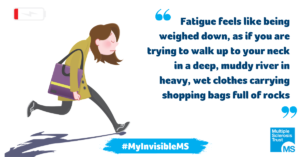
This seems to be a symptom that many people report going away with HSCT. If this alone were to lift, it would be worth everything.
Bladder Issues
We may now be dipping our toes into the arena of “TMI”, so feel free to leave this party now if you would like.
I am a member of an amazing group of women with MS who have been meeting weekly now for a year through Zoom. We found each other last February through an online physical therapy program called “the MS Gym”, but our friendship and conversations quickly evolved beyond the confines of that initial spark.
We all have bladder issues. The space that we have created has given us the safety and trust to talk about these very personal issues and support each other finding solutions. My bladder issues are a double-edged sword. I have both urinary frequency as well as urinary retention. This means I very frequently have to pee, and right away, pretty much every hour. It also means that my bladder doesn’t fully empty when I do pee leaving me susceptible to urinary tract infections (UTIs). Every one of us in our group has one or both symptoms. It is nice to not feel alone.

Through our most recent conversations on this topic, it has become clear to me that I need to see a urologist. I have been putting it off because I’ve been mostly able to manage without accidents or too many UTIs, but it could probably be easier with medical help.
This is another symptom that people commonly report improves or goes away with HSCT. I will wait to see how this symptom is impacted when I get back. In the meantime it makes it necessary for the airline flights, and a couple of long treatment days, to stick a few Depends in my carry-on.
Bowel Issues
Warning, even more TMI! This one will be brief. Like bladder issues, bowel issues can also be a double-edge sword. Most of the time people with MS experience constipation related to a decrease in smooth muscle motility that is directly caused by MS. In addition many of the medications we take have constipation as a side effect, increasing the problem. Baclofen is a medication that many people with MS, including me, use to help decrease spasticity and it’s a bugger for constipation.
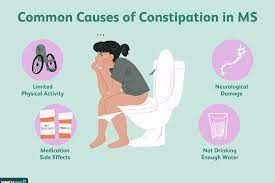
On the flipside, it is not unheard of to have a very unexpected and unpredictable moment of “bowel urgency”. This is not diarrhea, just the inability of the anal sphincter to do its retention job, I will leave it at that. Yet one more symptom that would make a world of difference if it resolved.